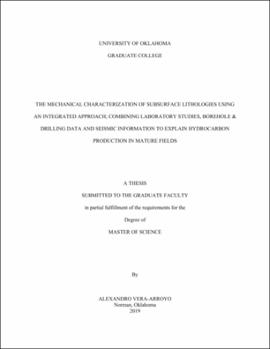| dc.description.abstract | In our current energy landscape, subsurface assessment challenges within the oil industry are becoming more difficult. Mature stage reservoirs present an opportunity to individually investigate different components of the industry, e.g. drilling, completion, wireline logs, and seismic data. However, in order to understand the mechanisms driving reservoir production, it is vital to expand our understanding of reservoir properties, the mechanical relationship between fluid and rock and important tectonic context.
Mexico’s oil industry has faced a major change in the last five years; however, PEMEX ® has managed to significantly expand activities in exploration and production of leased areas. Vast areas of these concession blocks have potential field data, seismic information (2D and 3D) and boreholes drilled with a complete suite of wireline logs. These areas are deeply studied and present an opportunity to integrate geophysics, geology and engineering inputs to understand the compelling drivers of production and production changes.
In this thesis, I explored the fundamental aspects related to two rock types that represent the present and future in terms of prospective resources, i.e. carbonate and shale reservoirs. On the first topic, my research focused on how the interpreted brittle behavior of the reservoir rocks deeply impacts the accumulative hydrocarbon production, and its competence to store wastewater. For the second research topic I conducted fieldwork to gather representative rock samples to screen for anisotropy and related anisotropic properties to hydraulic fracture propagation.
To investigate the Mississippi Lime, I used multiple datasets located in northern Oklahoma. Oklahoma, in particular Osage county, has been intensively drilled since the first well was completed in 1896. By 1982 Osage county was second nationwide for wells drilled with more than 35,000 drilled wells and produced more than 450 million barrels of Oklahoma crude oil. This production was due to a high density of drilled wells. Given the well density of the area, an unintended benefit of the boreholes per square kilometer was obtaining deep insight into the physical properties of the subsurface, i.e. resistivity, sonic information, rock description, water saturation, etc. Using gravimetry and magnetic data recorded in the area and correlating the basement geometry with seismic information in southeastern Osage county, I established a fault architecture for the area. From borehole wireline logs, I investigated the dynamic elastic properties. Using rock-physics models, seismic data, and P-impedance inversion, I laterally extended the determined properties over the study area. Additionally, I computed rock mechanic properties at singular borehole positions and extended these properties using seismic inversion correlated with borehole log data. Finally, I calibrated my results using geomechanical models of several wells to determine the Brittleness Index (BI). | en_US |
